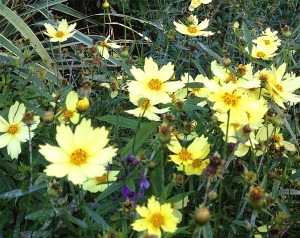A mainstay of perennial gardens, many of us have a love/hate relationship with coreopsis. Other than the native species, many seem to be difficult for folks here. The taller, earlier ones need constant deadheading to look their best, and the smaller flowered, wispy foliaged (verticillatas) need cutting back as soon as their initial bloom is done to keep them looking neat.

Coreopsis ‘Full Moon’
A couple of years ago I bought this coreopsis for the shop, hoping the flower color and the plant would work well here. I’m happy to say it has been an absolutely wonderful addition to my hot, sunny front bed, consorting quite happily with roses, daylilies, Mexican sage, rosemary, yucca (Yes, it’s very hot!), gaura, green santolina, mecardonia, Mexican heather, and various other heat loving plants.

With annual red gomphrena, ornamental blueberry,
yucca, and hypericum shrubs – Kris’ front bed
In fact, I sent pictures of it in various stages through the summer to one of my local growers, and, with each picture, a note saying, “Please grow this so I can pass it along to other Birmingham gardeners!” Well, I’m very happy to say she did, and we have Coreopsis ‘Full Moon’ available from our local wholesaler right down the road in Alabaster!

Coreopsis ‘Full Moon’ in Kris’ front bed with annual purple angelonia
I honestly can say this Coreopsis ‘Full Moon’ bloomed in my garden from June through the hottest part of summer and only started to wane in August – an unbelievable bloom time for a perennial. The color is a soft, buttery yellow like ‘Moonbeam’ coreopsis, but the foliage is more substantial and the flowers themselves are much larger.These are available now if you’d like to try one or more!

Coreopsis ‘Full Moon’ is a winner!
Tip: A great way to get even longer bloom from a perennial like this is to cut it back by half early in the season, and even better is to cut half of your plants back by half. That way the stems that haven’t been cut back bloom first. Those you cut back will bloom a bit later, thus extending your bloom period. Look at this post for more information on this technique – happy gardening!
